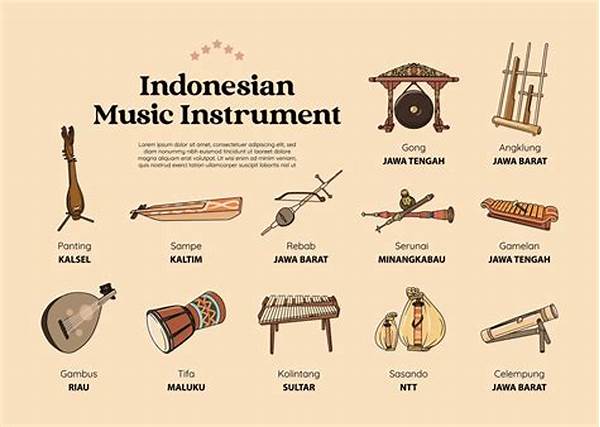Welcome to the kaleidoscope of sound that is Indonesia, a country as rich in melody as it is in culture. If you think you know music, think again! Imagine being serenaded by the unique sounds of the gamelan, or being immersed in the rhythmic beats of the kendang, each note echoing centuries of tradition and storytelling. Ready to dive into a realm where history dances along with notes and melodies? Whether you’re a seasoned musician looking for inspiration or simply a curious soul on a journey through the annals of music, this is your backstage pass to a world unknown.
Read More : Musical Instrument That Became The National Symbol Of Cultural Identity
In this blog, we’re going to unravel the tapestry of traditional Indonesian musical instruments and their origins. But beware! This is no boring lecture, dear reader. We’re talking juicy, toe-tapping tales filled with intrigue, culture, and a dash of musical gossip. Yes, musical gossip—ever wondered what instruments are whispering when they meet? It’s about time you found out! And who knows? You might even end up with a new favorite instrument or two.
The Melodious History: Exploring Traditional Instruments
When talking about lists of traditional Indonesian musical instruments and their origins, the gamelan is often the star of the show. Originating from the islands of Java and Bali, this ensemble of percussive instruments plays a crucial role in Indonesian culture, especially during ceremonies and theatrical performances. Its origins trace back to ancient times, with some historians linking its emergence to the bronze instruments of the ancient Dong Son culture in Vietnam.
But that’s not where the story ends. Picture an island where each note crafted by instruments echoes the footsteps of kings and warriors. The angklung, another jewel in the crown of Indonesian music, is an instrument made of bamboo tubes attached to a bamboo frame. Originating from West Java, the angklung produces sounds as vibrant as the island’s lush rainforests and serves both musical and educational purposes. In fact, it has made its mark globally due to its recognition by UNESCO as a Masterpiece of the Oral and Intangible Heritage of Humanity.
Gamelan: The Heartbeat of Javanese and Balinese Music
Dancing its way through the archipelago, the gamelan plays the leading role in theatrical performances and religious ceremonies across Java and Bali. A symbol of Indonesia’s musical heritage, it’s a confluence of metallophones, xylophones, drums, and gongs, meticulously tuned to complement each other. The gamelan not only serves musical purposes but weaves narratives that bind communities together. Imagine sitting in a courtyard with the stars as your canopy, mesmerized as the gamelan narrates epic tales of gods, goddesses, and mythical creatures. The experience is nothing short of magical.
Exploring Unique Rhythms: The Kendang and More
Step aside, western drums; it’s time for the kendang to take the spotlight. Integral to gamelan ensembles, the kendang is the rhythmic heart that dictates tempo and dynamics. Originating from Java, it holds the power to transform any gathering into an electrifying event. Don’t be surprised if you find your feet tapping along!
Speaking of captivating rhythms, the suling, a bamboo flute, charms listeners with its ethereal notes. Originating from the Sundanese region, it offers a haunting tune that complements the kendang’s beats. Together, they paint an auditory masterpiece, with each note taking you on a journey through the lush landscapes of Indonesia.
Read More : List Of Basic Chemistry Laboratory Instruments
Indonesia’s Musical Mosaic: A Symphony of Stories and Origins
The list of traditional Indonesian musical instruments and their origins is incomplete without mentioning other gems like the sasando from Rote Island and the rebab from West Java. The sasando, a unique string instrument resembling a harp, creates melodies that float effortlessly, reminiscent of ocean waves. Its origins are deeply rooted in the island’s traditions and folklore, singing tales of love and adventure.
Meanwhile, the rebab—a two-stringed bowed instrument—enriches gamelan performances with its melancholic and melodic voice. It’s an ancient instrument that continually adapts, molding itself into various cultural narratives across the archipelago.
The Cultural Symphony of Indonesia
In conclusion, exploring the list of traditional Indonesian musical instruments and their origins is akin to embarking on an epic journey through time. Each instrument doesn’t just play a note or melody; it tells a story, weaves history, and builds bridges across generations. The rhythm of a kendang might remind one of bustling marketplaces, while the soft strains of the suling can transport you to the tranquil highlands of Java. These instruments serve as cultural ambassadors, illustrating the rich tapestry of Indonesia’s multi-faceted identity.
As you’ve traveled through this melodious journey, perhaps you’ve felt the resonance of history or glimpsed the dances of long-forgotten ancestors. Maybe you’ve even discovered a newfound appreciation for the intricate artistry that embodies Indonesian music. It’s not just sounds, folks. It’s a living, breathing narrative, a legacy crafted through centuries, inviting you to become a part of its unfolding story. Plan your musical pilgrimage, and let the spirit of Indonesia serenade you in person.
